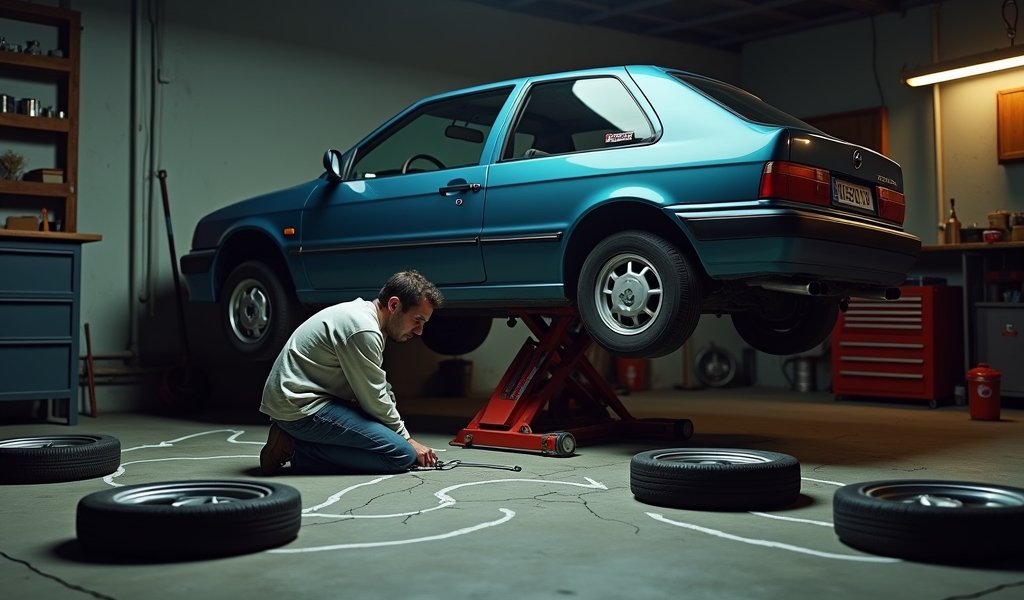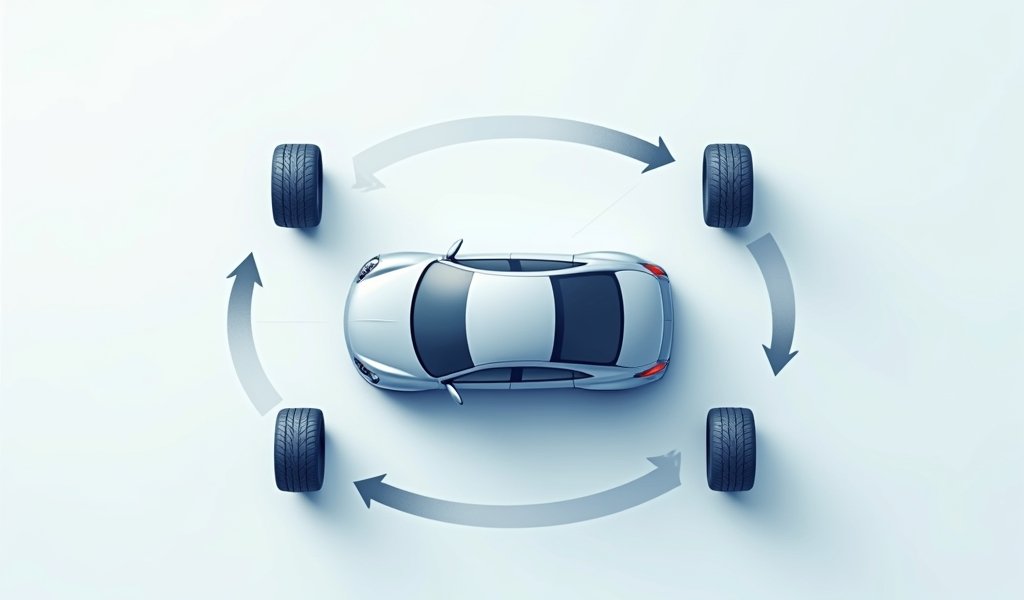Overview
This article explains proper tire rotation patterns for different vehicle types (FWD, RWD, AWD), highlighting how regular rotation every 5,000-7,500 miles extends tire life by up to 20% while improving safety, handling, and fuel economy. It provides detailed guidance on choosing the correct rotation pattern based on drivetrain and tire type, along with step-by-step instructions for DIY rotation and troubleshooting tips for common issues.
Table of Contents
- Understanding Tire Rotation: More Than Just Swapping Positions
- The Benefits of Regular Tire Rotation
- Common Tire Rotation Patterns Explained
- Vehicle-Specific Rotation Patterns
- Directional and Non-Directional Tires: Special Considerations
- When to Rotate Your Tires
- DIY Tire Rotation: A Step-by-Step Guide
- Common Tire Rotation Mistakes to Avoid
- Conclusion
- Frequently Asked Questions
Understanding Tire Rotation: More Than Just Swapping Positions
Tire rotation pattern specification is one of those maintenance procedures that doesn’t get the spotlight it deserves. As a mechanic with 15 years under my belt, I’ve seen countless tires tossed prematurely because folks skipped this simple service. Your tires wear differently depending on their position on your vehicle – it’s just physics. Front tires on a front-wheel drive car shoulder the burden of steering, acceleration, and most braking forces, while rear-wheel drive vehicles place different stresses on their rear tires.
Think of tire rotation as giving each of your tires a chance to experience life from different angles. By moving them to different positions according to specific patterns, we distribute wear evenly across all four corners. This isn’t just about saving money (though you’ll certainly do that) – it’s about maintaining optimal handling, traction, and safety throughout your tires’ lifespan.
The beauty of proper tire rotation lies in its simplicity. With the right pattern for your vehicle, you’ll extend tire life by up to 20% and improve fuel efficiency along the way. Let’s get into the nitty-gritty of how to do this right.
The Benefits of Regular Tire Rotation
Before we dive into the specific patterns, let’s talk about why we’re doing this in the first place. I’ve had customers question whether rotation is really necessary – trust me, the benefits are substantial:
- Extended tire life – You’ll get thousands of additional miles from each set
- Improved fuel economy – Evenly worn tires create less rolling resistance
- Enhanced traction and handling – Critical for wet weather driving safety
- Reduced noise – Unevenly worn tires often develop humming or vibrations
- Warranty compliance – Most tire warranties require regular rotation
I recently helped a customer who had never rotated their tires. The front pair was nearly bald while the rears looked almost new. That’s money left on the table! By implementing a proper rotation schedule, all four tires wear at approximately the same rate, meaning you’ll need to replace the entire set at once – which is actually preferable for balanced handling.
When tires wear evenly, your vehicle’s alignment specifications remain more stable, meaning you’ll have more predictable handling in emergency situations. That alone makes rotation worth every minute spent.

Common Tire Rotation Patterns Explained
Now for the meat and potatoes: understanding the different rotation patterns. There’s no one-size-fits-all approach here – the pattern you’ll use depends primarily on your vehicle’s drivetrain and tire type.
Forward Cross Pattern
This pattern is ideal for front-wheel drive vehicles, the most common drivetrain on today’s roads. Here’s how it works:
- Front tires move directly to the rear, maintaining the same side
- Rear tires move to the front, but switch sides (right rear to left front, left rear to right front)
This pattern addresses the heavier wear that front tires experience in FWD vehicles by giving all tires a chance to serve in different positions. I recommend this pattern to most of my everyday drivers with front-wheel drive sedans and crossovers.
Rearward Cross Pattern
If you’re driving a rear-wheel drive or four-wheel/all-wheel drive vehicle, the rearward cross is typically your best bet:
- Rear tires move straight to the front position, same side
- Front tires move to the rear, but cross sides (right front to left rear, left front to right rear)
This pattern accounts for the increased torque applied to rear tires in these drivetrains. According to NHTSA recommendations, this pattern provides the most even wear for vehicles where the rear or all wheels deliver power to the road.
X-Pattern
The X-pattern is becoming increasingly popular, especially for all-wheel drive vehicles:
- Each tire moves diagonally to the opposite corner (RF→LR, LF→RR, RR→LF, LR→RF)
This creates an “X” in your rotation scheme and excels at distributing wear across all four tires in vehicles where power distribution can vary between wheels.
Side-to-Side Rotation
Some vehicles require a simpler approach where tires only swap left to right while staying on the same axle. This is typically used when:
- Front and rear tires are different sizes
- Directional tires are used and remounting isn’t practical
While not as effective as cross patterns, side-to-side rotation still provides better wear distribution than no rotation at all.
Vehicle-Specific Rotation Patterns
Different vehicles demand different approaches to tire rotation. Let’s break it down by vehicle type:
Front-Wheel Drive Vehicles
FWD vehicles place enormous stress on front tires, which handle steering, driving force, and approximately 60% of braking duty. The forward cross pattern works wonders here, though the X-pattern is also effective. If you’re noticing uneven shoulder wear, you might want to calculate your wheel offset to ensure proper fitment isn’t contributing to the issue.
Rear-Wheel Drive Vehicles
With RWD, power delivery through the rear wheels creates unique wear patterns. The rearward cross pattern is typically ideal, allowing every tire to serve in each position eventually. Performance RWD vehicles with staggered setups (different size front/rear tires) will be limited to side-to-side rotation only.
All-Wheel/Four-Wheel Drive
AWD and 4WD systems vary significantly between manufacturers. While the rearward cross pattern is generally recommended, some vehicles benefit more from the X-pattern. Check your owner’s manual for manufacturer specifications – they’ve tested your exact vehicle extensively.
Performance and Specialty Vehicles
High-performance vehicles often use staggered tire setups with larger rear tires. In these cases, rotation options are limited to side-to-side only, or rotation might not be possible at all. Some exotic vehicles have specific rotation requirements that may differ from standard practices.
Directional and Non-Directional Tires: Special Considerations

Not all tires are created equal, and their design significantly impacts how they should be rotated.
Identifying Directional Tires
Directional tires feature tread patterns designed to rotate in one specific direction, usually indicated by arrows or “This Side Out” markings on the sidewall. These tires excel at channeling water away in wet conditions but require special handling during rotation.
If you have directional tires, your rotation options are limited to front-to-back on the same side of the vehicle. Crossing them to the opposite side requires dismounting and remounting the tires on their wheels – a job typically best left to professionals with proper equipment.
Non-Directional Tires
Most vehicles come equipped with non-directional tires, which can be rotated using any of the standard patterns we’ve discussed. This flexibility makes maintenance simpler and more cost-effective over the life of your tires.
Asymmetrical Tires
These performance-oriented tires have different tread patterns on the inner and outer portions of the tire. They’re marked with “Outside” on the outer sidewall and can generally be rotated using standard patterns as long as the “Outside” marking remains facing outward.
Mixed Setups
Some vehicles use different sizes front-to-rear or mix directional with non-directional tires. In these cases, your options may be limited to side-to-side rotation only, or professional remounting may be required. When in doubt, consult your owner’s manual or a trusted mechanic.
When to Rotate Your Tires
Getting the timing right is crucial for maximizing the benefits of tire rotation. Here’s what I recommend to my customers:
Mileage Guidelines
Most manufacturers and tire experts recommend rotating tires every 5,000 to 7,500 miles. This conveniently aligns with oil change intervals for many vehicles, making it easy to remember. However, if you regularly tow heavy loads, drive on rough terrain, or notice uneven wear, consider a shorter interval of 3,000 to 5,000 miles.
Visual Indicators
Don’t rely solely on mileage. Keep an eye out for these warning signs that suggest your tires need rotation:
- Uneven tread wear becoming visible
- Vehicle pulling slightly to one side
- Increased vibration at certain speeds
- Noticeable difference in tread depth between tires
Before taking a long road trip, I always suggest checking your tires thoroughly, including rotation status. Nothing ruins a vacation faster than tire trouble hundreds of miles from home.
Seasonal Considerations
If you live in an area with distinct winter conditions and use seasonal tires, the transition periods make perfect timing for rotation. Rotate your all-season tires before storing them for winter, and do the same with your winter set before tucking them away for summer.
DIY Tire Rotation: A Step-by-Step Guide
For the mechanically inclined, tire rotation is a manageable DIY project. Here’s my step-by-step process for safe and effective rotation:
Tools You’ll Need
- Jack rated for your vehicle’s weight
- Jack stands (never work under a vehicle supported only by a jack!)
- Lug wrench or impact wrench
- Torque wrench
- Wheel chocks
- Clean, level work area
Preparation Steps
Begin by gathering your owner’s manual to confirm the recommended rotation pattern and torque specifications. Park on level ground, engage the parking brake, and place wheel chocks on the wheels that will remain on the ground during jacking.
Rotation Procedure
- Loosen (but don’t remove) all lug nuts while the tires are still on the ground
- Jack up the vehicle and secure it properly on jack stands
- Remove the wheels and arrange them according to your chosen pattern
- Reinstall each wheel in its new position, hand-tightening the lug nuts
- Lower the vehicle until the tires contact the ground but don’t bear full weight
- Tighten all lug nuts to proper torque specifications in a star pattern
- Lower the vehicle completely and double-check all lug nuts
Take this opportunity to inspect each tire for damage, embedded objects, and irregular wear patterns. Also check brake components while the wheels are off – it’s free preventative maintenance!
When to Seek Professional Help
While tire rotation is generally DIY-friendly, consider professional service if:
- You have directional tires that need remounting
- You notice unusual wear patterns that might indicate alignment issues
- You don’t have proper equipment to safely lift and support your vehicle
- You encounter rusted or damaged lug nuts
Common Tire Rotation Mistakes to Avoid
After years in the shop, I’ve seen plenty of rotation-related mistakes. Here are the most common pitfalls to avoid:
Using the Wrong Pattern
Applying the wrong rotation pattern for your vehicle type can accelerate uneven wear rather than prevent it. Always verify the correct pattern for your specific drivetrain configuration.
Ignoring Tire Pressure
After rotation, check and adjust tire pressure to manufacturer specifications. Different positions on your vehicle may have experienced different pressure changes, and proper inflation is crucial for even wear.
Forgetting to Retorque
Metal expands and contracts with temperature changes. It’s good practice to recheck lug nut torque after driving about 50-100 miles following a rotation. I’ve seen too many wheels come loose because this step was skipped.
Rotating Worn-Out Tires
If your tires are already worn beyond their useful life (typically 2/32″ tread depth or when wear bars are flush with the tread), rotation won’t help. You need new tires at this point, not a new position for dangerous ones.
Mixing Different Rotation Schedules
Consistency is key. Stick to your chosen interval and pattern for best results. Haphazard rotation timing or constantly changing patterns won’t deliver the benefits you’re looking for.
Conclusion
Proper tire rotation pattern specification isn’t just mechanic mumbo-jumbo – it’s a crucial maintenance practice that extends tire life, improves safety, and saves you money. The right pattern for your vehicle depends primarily on your drivetrain type, with front-wheel drive vehicles typically benefiting from the forward cross pattern, while rear and all-wheel drive vehicles usually do best with the rearward cross pattern.
Remember to rotate every 5,000-7,500 miles or according to your manufacturer’s recommendations. Take advantage of this service opportunity to inspect your tires for damage and unusual wear patterns that might indicate other issues needing attention.
Whether you tackle rotation yourself or visit a professional shop, the important thing is making it a regular part of your maintenance routine. Your tires are literally where the rubber meets the road – give them the care they deserve, and they’ll return the favor with thousands of extra miles of safe, efficient service.
Frequently Asked Questions
How often should I rotate my tires?
Most manufacturers recommend every 5,000-7,500 miles, which conveniently aligns with oil change intervals. Vehicles used for towing or off-road driving may benefit from more frequent rotation at 3,000-5,000 mile intervals.
Can I rotate my tires myself?
Yes, if you have the proper equipment including a jack, jack stands, lug wrench, and torque wrench. Always follow safety precautions and never work under a vehicle supported only by a jack.
What’s the best rotation pattern for an SUV with all-wheel drive?
Most AWD SUVs do best with the rearward cross pattern, though some manufacturers may specify the X-pattern. Check your owner’s manual for vehicle-specific recommendations.
Do I need to balance my tires after rotation?
Not typically, as the wheel and tire assembly remains together during rotation. However, if you notice vibration after rotation, a balance check may be necessary.
What should I do if my tires are directional?
Directional tires can only be rotated front-to-back on the same side of the vehicle without remounting. If cross-rotation is needed, the tires must be dismounted and remounted on their wheels by a professional.

